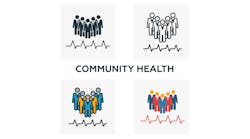The Parkland Center for Clinical Innovation (PCCI) in Dallas has spent the past three years developing and testing predictive models to identify children at risk for asthma exacerbations. Combining those models with clinical and population health interventions has led to improved outcomes, says PCCI, which is now turning its efforts to pre-term births.
This targeted population health effort was funded by Parkland Community Health Plan, the largest Medicaid plan in the Dallas area. PCCI has eight clinicians on staff, including two pediatricians by training. “They intuitively knew that for the population we are serving pediatric asthma is typically not well managed and is a high-cost condition,” said Steve Miff, president and CEO of PCCI.
A deep-dive analysis of the data for the health plan identified areas that had the largest expenditures and where there was the most variation in care and potential overutilization for services, such as emergency room visits for asthma, he said.
“We had to understand the disease itself and where these children receive care in the community.”
PCCI has built a predictive model to risk-stratify the children into different cohorts based on the likelihood that their asthma condition would exasperate over the next three months and likely require emergency department visits or hospitalizations. The model itself uses claims data, EHR data, social determinants of health information, which might include gaps in insurance coverage. “We also ingested and used data from EPA sensors in the community about air quality,” Miff said. That has been only marginally useful so far because the sensors are not specific enough to be able to attribute to an individual,” he said, “so we are working with local universities and some companies that are deploying sensors to get data on air quality that is more real-time and more specific.”
Part of the project involves being more proactive with clinicians and patients. It sends alerts to the 21 physician practices involved before visits with these patients. Because the payer is involved, the case manager at the health plan gets a risk-stratified list of patients. The risk manager use that to focus on the very high-risk cohort, Miff said.
“We also engage directly with the children and families themselves in their home,” he said. “We enroll the very high-risk cohort into a texting program.” They receive texts multiple times per week with reminders about upcoming appointments, reminders about the need to take their medication, and ongoing education about their condition so it stays top of mind. “What is cool is that they 70 percent rated it very useful in a survey, and over a 12-month period, we saw only 15 percent attrition, which is pretty fantastic when you think about the frequency of engagements.”
Miff said that over the last three years, this has proven to be an effective way to engage individuals. “We have expanded the number of clinics and individuals involved and we have continued to refine the model.
He pointed to some key improvements: The program is saving the health plan around $6 million per year in costs for this population. “Contributing to that is that we have seen a 31 percent drop in ED visits and we have seen a 42 percent drop in in-patient admissions for the population,” he said. Alerts embedded in clinicians’ EHRs and monthly progress reports have led to up to 50 percent improvement in asthma controller medication prescriptions and a 5 percent improvement in the asthma medication ratio.
PCCI also did a cross-market analysis to compare apples to apples with other Medicaid insurers. The overall Dallas-Fort Worth Medicaid managed care market saw ED visits decline 5 percent over the past three years in a similar population. The overall market is making progress, Miff said, but a similar cohort within Parkland Community Health Plan had a 31 percent drop.
PCCI also found that the children most actively engaged with texting had even better outcomes in terms of reduced ED utilizations.
PCCI did have a cohort of high-risk children they could not get engaged via the texting program. They designed a pilot to use Amazon Echo Alexa as a personal assistant and a group interaction to gamify this process for those individuals. The Echo is programmed to ask questions about their asthma. The children win together as a group if they participate on a regular basis and their knowledge about their condition improves. “The results are not in on that pilot in terms of how long they stay engaged,” Miff said, “but it is an interesting way to engage them in the home.”
Looking at other cohorts that are costly, have high utilization and are not favorable for patients, they chose pre-term birth as a next target. “Nine months ago, we launched a pilot to look at that population,” Miff said, “and we are rolling out a subgroup of that population looking at gestational diabetes using a similar approach and model.”
“For the sub-cohort on gestational diabetes, we need additional information if we are going to engage with them at home. It is not enough to build these models based on the most recent clinical or claims data or social determinants,” Miff said. “We need more real-time information about their condition, so we have included remote monitoring devices to extract real-time data about three things: blood pressure, blood glucose and weight so we can monitor those.” PCI is designing the predictive models that take those into account. For the general diabetic population, they are focusing on the diabetic foot ulcer population.
PCCI’s impressive results with predictive modeling and patient outreach have drawn interest from other Medicaid plans.
“We are at a point where this is ready to be tested in other environments,” Miff said. “We are in advanced discussions with two other Medicaid plans in other parts of the country, and in advanced discussions with one commercial payer with an employer population to test these models. They will have to figure out to adjust the predictive models and the work flows and the in-home outreach from a technology perspective.”


